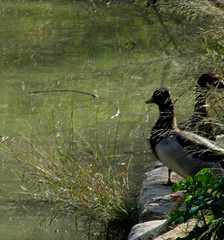La base de esta inversión de las nociones generalmente aceptadas le lleva un poco más lejos—a proponer que vivimos no en la realidad física que solemos creer, sino en una realidad virtual, institucional o simbólica. Que lo que tomamos por objetos son símbolos... de palabras, de ideas, y de sí mismos.
Los individuos que encontramos por el mundo, objetos o seres vivos o personas, son ejemplos particulares o manifestaciones de las ideas o formas platónicas que se manifiestan en las palabras que a todos esos individuos son aplicables. El lenguaje da forma a las actitudes sociales y las acuña en forma de palabras aplicables a las cosas. Y así las cosas del mundo se vuelven ejemplificaciones materiales de los valores que el idioma de la tribu ha depositado en esas palabras.

"Thus, in mediating between the social realm and the realm of nonverbal nature, words communicate to things the spirit that the society imposes upon the words which have come to be the 'names' for them. The things are in effect the visible tangible material embodiments of the spirit that infuses them through the medium of words. And in this sense, things become the signs of the genius that resides in words. The things of nature, as so conceived, become a vast pageantry of social-verbal masques and costumes and guildlike mysteries, not just a world of sheer natural objects, put a parade of spirits, quite as the grass on a college campus has its meaning for us, not just as physical grass, but because of its nature as symbolic of the promises and social values associated with the order of formal education. In a subtler way, it is suggested, all nonverbal 'nature' is in this sense not just itself for man, the word-using animal; rather, for man, nature is emblematic of the spirit imposed upon it by man's linguistic genius." (362)
Habitamos, pues, en la realidad virtual del lenguaje, y, como los personajes de Matrix, la confundimos con una realidad sustancial y directa, no problemática. El propio Burke nos remite como precedente a Emerson y a su noción de que somos símbolos y de que habitamos símbolos; para Emerson, para Burke, para este que escribe, habitamos un paisaje hecho de palabras transformadas en cosas, y la ilusión es perfecta.
—oOo—
Otra versión de la estructuración lingüística de la realidad aparece en T. S. Eliot—en su tesis doctoral Knowledge and Experience in the Philosophy of F. H. Bradley (1916), un excurso de la cual comenta así Burke:
I refer to a sudden flurry on pages 132-135, proclaiming the all-importance of words or names in shaping the objects of attention. "Without words, no objects," he asseverates. Thus he questions whether "the explicit recognition of an object as such" can occur "without the beginnings of speech." The bundle of things that we call an object "would not be a bundle unless it were held together by the moment of objectivity which is realized in the name." After three pages that develop this line of thought vigorously, he breaks off (...). Other relevant sentences in the thesis are: "In any knowledge prior to speech the object is not so much an identity recognized as such as it is a similar way of acting; the identity is rather lived out than known. What we are here concerned with is the explicit recognition of an objet as such, and I do not believe that this occurs without the beginnings of speech . . . . Our only way of showing that we are attending to an object is to show that it and ourself are independent entities, and to do this we must have names . . . . We have no objects without language."
Il n'y a pas de hors-texte, tampoco para Eliot. Decía Trotsky, parodiando al evangelio de San Juan, que en el principio era (no el verbo, sino) la acción. Es cierto, pero el mundo humano que habitamos se construye con esa forma de acción que es hacer cosas con palabras.

0 comentarios